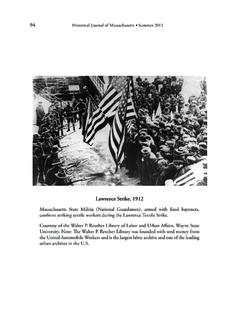Transcription of Cranberry Pickers Mural Wareham Post Office
1 Historical Journal of Massachusetts Summer 20112 Cranberry Pickers MuralWareham Post Office3 Cranberry Pickers Mural at the Wareham Post OfficeBERNICE L. THOMASI ntroduction: Massachusetts is the second largest Cranberry producing state in the nation. In 2009, Wisconsin ranked first (56 percent of national production), followed by Massachusetts (29 percent). The third highest-ranking state, New Jersey, produced only 7 percent of the national Today cranberries are the commonwealth s most important agricultural product, valued at over $120 million annually. They are grown on approximately 14,000 acres in the southeastern part of the state.
2 In addition to cropland, more than 60,000 acres of open space are associated with Cranberry production, providing a protected habitat for many plant and animal species. This open space also serves to protect and recharge local watersheds. An iconic symbol of our national heritage, Cranberry harvesting has a rich but often overlooked history. In this photo essay, Bernice L. Thomas analyzes a New Deal post office Mural that commemorated Cranberry harvesters. Thomas is a Vassar College graduate with a PhD in Art History from Boston * * * * *Historical Journal of Massachusetts, Vol. 39 (1 & 2), Summer 2011 Institute for Massachusetts Studies, Westfield State UniversityPHOTO ESSAYH istorical Journal of Massachusetts Summer 20114 Lewis Rubenstein s Cranberry Pickers Mural , painted on the wall of the Wareham Post Office in 1940, is one of over a thousand murals in post office lobbies across the country executed during the Roosevelt New Deal era.
3 Despite what is generally assumed, New Deal murals in America s post offices were not paid for by the Works Project Administration (WPA). Rather, they were underwritten by the Department of the Treasury s Section of Painting and Sculpture as part of a program to help support artists during the Great Depression. Another purpose was to expose Americans in small communities to original works of art when they came into post office lobbies. The assumption was that citizens in small towns where the murals were placed had rarely seen an original work of Wareham Mural was executed by the accomplished artist, Lewis Rubenstein (1908- 2003), who spent two years in France and Italy on a fellowship from Harvard after his graduation in 1930.
4 His purpose was to explore the almost-forgotten Renaissance technique of fresco painting and bring it back to the where he taught the method in various colleges and museums around the Boston In 1940, Rubenstein won a competition to paint a Mural in the Wareham Post Office lobby. For this, he was paid $ are a distinct American plant. Along with the blueberry and the Concord grape, the Cranberry is one of North America s three native fruits. It was first used by Native Americans who discovered the berry s versatility as a food, a healing agent, and a fabric As a food, cranberries would eventually accompany many American s Thanksgiving s choice of subject, Cranberry Pickers , was eminently suitable for that particular post office because Wareham was the center of Cranberry production and research in America in 1940.
5 His illustration of Cranberry production as practiced in 1940 met more than one criteria. It no doubt pleased the Section s Assistant Chief, Edward R. Rowan, because it met his direction to Lewis Rubenstein: better to focus on objective reality than on The artist was able to paint in more than one way at once. Besides being recognizably true to life, the Mural reflects the artistry of early Renaissance painters at the same time. The flat surfaces and limited palates of this Mural particularly call to mind the great Italian artist, Piero della the time Rubenstein painted Cranberry Pickers , the objective reality was that only migrant workers from the Cape Verde Islands off the coast of West Africa were used to pick cranberries.
6 For some, this was not a particularly proud accomplishment. Edward B. Garside wrote a novel 5 Cranberry Pickers MURALL ewis Rubensteinin 1938 entitled Cranberry Red that chronicles the hardships faced by the largely Cape Verdean bog laborers and the discrimination they Lewis Rubenstein chose to depict the Cape Verdeans in a uniformly respectful manner. The principle figure in the Mural the large Cape Verde woman in the center of the foreground with her arms outstretched is both natural and iconic at the same time. The figure helps to bring the viewer into the scene. The two smaller men in the middle ground wearing broad brimmed hats add interest.
7 This is especially true of the man on the right Historical Journal of Massachusetts Summer 20116sitting on the ride-on, dry harvester. The main figures provide contrast to the other Cape Verdeans distributed among the Cranberry bogs. All of the migrant workers appear to be concentrating on the task at hand. Overall the Mural has a simple dignity coupled with a good deal of artistic appeal in terms of color and growing required specialized conditions, which the Mural reflects. Contrary to popular belief, cranberries do not grow in water. Instead, they grow on vines in nearly impermeable beds layered with sand, peat, gravel, and clay. These beds, commonly known as bogs, were originally made by glacial deposits.
8 An undamaged Cranberry vine will survive indefinitely. Some vines in Massachusetts are over 150 years The University of Massachusetts at Amherst established a Cranberry Experiment Station research facility in Wareham in 1910. Dr. Henry J. Franklin served as director. That very year a more efficient rocker scoop than had previously been used to harvest cranberries was developed at the research station. In 1920 Oscar Tervo invented the first mechanical, ride-on, dry harvester, known as the Matthewson. In 1930, Ocean Spray Cranberries Incorporated was formed as a grower-owned marketing cooperative. Commercial Cranberry growing continues to flourish in Massachusetts Detail7 All told, the painting accurately mirrors the scenery of the Cranberry bogs in 1940, including the hand equipment, the machinery, and the appearance of migrant workers from the Cape Verde Islands as the sole harvesters of the locally grown red berries.
9 Cranberry Pickers , signed and dated by Lewis Rubenstein in the lower right-hand corner, remains today in the Wareham Post Office as a handsome work of art and as valuable documentation of life as it was known in that place almost seventy years ago. HJMN otes1 Massachusetts Cranberries, Jan. 25, 2010 Published by New England AgriculturalStatistics. (accessed February 16, 2010).2 Help with this article was provided by Patricia Groves, Supervisor of Customer Service at the Wareham Post Office, and Aaron Thomas, the author s son, who did much of the technical research on the Bernice L. Thomas, The Stamp of FDR: New Deal Post Offices in the Mid-Hudson Valley (Fleischmanns, NY: Purple Mountain Press, 2002), Rebecca E.
10 Lawton, Chronological Biography, in Ruth Middleton, ed., Lewis Rubenstein: A Hudson Valley Painter (Woodstock, NY: Overlook Press, 1993), History of Cranberries, Cape Cod Cranberry Growers Association. (accessed January 22, 2011).7 Lawton, Karal Ann Marling, Wall-to-Wall America: A Cultural History of Post Office Murals in the Great Depression (Minneapolis: University of Minnesota Press, 1982), 35f. Other American muralists besides Rubenstein evinced a strong affinity for the work of Italian fresco artist, Piero della Francesca. Marling notes that Boardman Robinson s ten-panel ensemble executed in 1930 in the Kaufman Department Store in Pittsburgh was said to possess the monumental solemnity of a fresco by Piero della Francesca as Cranberry Culture in Massachusetts, Maine Folklife Center.











